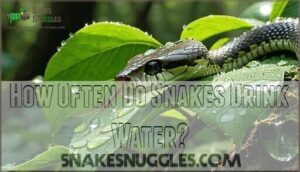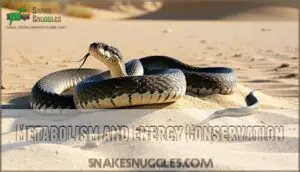This site is supported by our readers. We may earn a commission, at no cost to you, if you purchase through links.

Young snakes need food every 5-7 days, while adults can go 1-2 weeks between meals.
Some species can actually survive months without eating.
Regarding water, you’ll want to provide fresh water constantly, though many snakes get moisture from their prey.
Their slow metabolism means they’re nature’s ultimate energy savers – like having a car that runs on one tank of gas for months.
The frequency depends on species, size, and temperature, but snakes are surprisingly low-maintenance when you understand their unique digestive timeline and hydration needs.
Table Of Contents
- Key Takeaways
- How Often Do Snakes Eat and Drink?
- Frequency of Snake Feeding
- Factors Affecting Snake Feeding and Hydration
- Feeding Practices for Captive Snakes
- Frequently Asked Questions (FAQs)
- How often do snakes eat and drink?
- How often should a snake eat a ball python?
- How often do snakes need to be fed?
- Do snakes eat a lot?
- How often should you feed a king snake?
- Do snakes eat at night?
- How long can a snake go without eating?
- How soon after a snake eats does it poop?
- Why do snakes eat so infrequently?
- How long can snakes go without food?
- Conclusion
Key Takeaways
- You’ll feed adult snakes every 1-2 weeks, while juveniles need meals twice weekly – their slow metabolism means they’re incredibly efficient energy savers compared to mammals
- Your snake can survive months without food if needed – large pythons can fast for up to 18 months, while smaller species still manage weeks without eating due to their ability to slow metabolism by 70%
- You should provide fresh water constantly, though many snakes get moisture from prey – drinking frequency varies dramatically by species, with desert snakes drinking weekly while semi-aquatic species drink multiple times daily
- You’ll find frozen prey is safer than live prey for captive snakes – it eliminates injury risks from defensive bites while providing the same complete nutrition your snake needs
How Often Do Snakes Eat and Drink?
Snakes typically eat every one to four weeks, though snake eating frequency varies dramatically by species.
Your ball python might feast monthly, while smaller species need weekly meals.
Snake drinking frequency depends on humidity and water intake needs.
Species variation affects both eating and drinking patterns – some desert snakes rarely drink, getting moisture from prey instead.
Baby snakes, for instance, often require more frequent meals for proper growth.
Frequency of Snake Feeding
You’ll find that snake feeding schedules aren’t like your daily meal routine, as most adult snakes eat only once every one to two weeks.
Young snakes require more frequent meals, typically twice a week, due to their higher energy needs and faster growth rates, which makes their feeding schedule distinct from that of adult snakes, with higher energy demands.
How Long Can Snakes Go Without Food?
You’ll be shocked to learn that some species can survive without food for incredibly long periods! Their remarkable metabolic rate allows them to slow down energy consumption by up to 72%.
Snakes can literally shut down their metabolism by 70% – turning their bodies into survival machines that defy belief!
Here’s what affects snake survival limits:
- Species variation – Pythons can fast for 18-19 months, while smaller snakes need food more frequently
- Size influence – Larger snakes store more energy and survive longer fasts than juveniles
- Health condition – Healthy snakes withstand longer periods without eating than sick ones
- Environmental factors – Cold temperatures slow snake metabolism, extending survival time
Many snakes exhibit prolonged fasting periods, sometimes up to several weeks.
How Often Do Snakes Eat?
In regards to snake feeding habits, you’ll find their meal frequency isn’t what you’d expect. Age and Size play vital roles – juveniles eat twice weekly while adults manage with meals every 1-2 weeks.
Species Variation creates dramatic differences in snake diet patterns, with pythons eating monthly but garter snakes dining weekly. Environmental Impact and Prey Availability shape how often snakes eat, while their Metabolic Rate determines snake meal frequency.
Consider these fascinating feeding patterns:
- Ball pythons can wait 2-4 weeks between meals
- Corn snakes prefer weekly dining schedules
- Anacondas feast monthly due to slower snake digestion rate
How Often Do Snakes Drink Water?
While snakes eat infrequently, their drinking habits tell a different story.
You’ll find that snake water intake varies dramatically between species and situations.
Most snakes don’t drink daily like mammals do.
Instead, they absorb moisture from their prey and drink when they encounter a suitable water source.
Drinking frequency depends on several factors.
Desert species like rattlesnakes might drink once weekly, while semi-aquatic snakes drink multiple times daily.
During shedding periods, shedding hydration becomes critical as snakes increase their water consumption to soften old skin.
Here are key insights about reptile drinking habits:
- Snake water requirements can change overnight during illness or stress
- Species variation means your pet’s needs differ vastly from wild cousins
- Hydration signs include clear eyes and elastic skin when gently pinched
- Water source quality affects how often snakes actually drink
Factors Affecting Snake Feeding and Hydration
You’ll find that several key factors determine how often your snake needs to eat and drink, including its age, size, species, and environmental conditions.
Temperature, seasonal changes, and metabolic rate work together to influence feeding schedules, with younger snakes requiring meals twice weekly while adults may eat only once every few weeks, influenced by their age.
Metabolism and Energy Conservation
Understanding snake feeding frequency requires grasping their incredible metabolic rate adaptations.
You’ll find that snakes excel at energy conservation through remarkable physiological adjustments.
Their ectothermic nature allows dramatic metabolic shifts based on environmental conditions, directly impacting snake water intake and feeding schedules.
Their metabolic rate definition includes the continuous internal chemical processes essential for life.
Here’s how their energy storage system works:
- Metabolic Rate drops up to 70% during fasting periods
- Seasonal Impact triggers brumation effects in colder months
- Energy Storage utilizes fat reserves efficiently during food scarcity
- Digestion Efficiency maximizes nutrient absorption from infrequent meals
Digestion and Recovery
After swallowing massive prey, your snake’s body transforms dramatically. Digestion time stretches from days to weeks, depending on prey size and the snake’s metabolic rate. Their organs expand substantially to process nutrients efficiently, while gut bacteria break down proteins and fats.
A snake’s entire body becomes a living digestive powerhouse, reshaping itself around each massive meal.
Snakes also depend on flexible jaw adaptations to consume large meals.
- Snake feeding habits adapt to extended digestion periods
- Recovery requires substantial energy before the next meal
- Waste elimination occurs only after complete nutrient absorption
This remarkable snake diet process explains why they eat so infrequently compared to other animals.
Physical Adaptations
After digestion wraps up, your snake’s physical adaptations become the real game-changers in feeding frequency. These reptiles pack some serious evolutionary advantages that’ll blow your mind.
Their jaw structure opens like a puzzle, allowing massive prey consumption. Meanwhile, their digestive system operates like a high-efficiency factory, extracting maximum nutrients.
Here’s what makes snake feeding habits so incredible:
- Expandable throat and stomach accommodate prey twice their head diameter
- Sensory organs detect heat signatures from potential meals
- Streamlined body shape reduces energy expenditure between hunts
- Specialized scale morphology provides protection during feeding
Understanding reptile hydration and how often snakes eat reveals nature’s perfect predator design.
Feeding Practices for Captive Snakes
When you keep a snake as a pet, you’ll need to understand proper feeding practices that differ substantially from wild snake behavior.
Your captive snake requires consistent feeding schedules, appropriate prey choices, and careful monitoring to maintain ideal health and prevent common feeding problems.
Live Vs. Frozen Prey
When choosing between live and frozen options for your snake’s meals, frozen prey wins hands down.
Here’s why this decision matters for your pet’s wellbeing:
- Live Prey Risks include defensive bites and scratches that can seriously injure your snake
- Frozen Prey Benefits eliminate injury risks while providing consistent nutrition
- Nutritional Differences are minimal, with frozen options meeting all snake diet requirements
- Ethical Considerations favor frozen prey, reducing unnecessary animal suffering
You can conveniently purchase reptile food online.
Proper prey size remains essential regardless of your choice.
Supplementation
Most snake owners rarely need to worry about supplementation when feeding whole prey.
Here’s the truth about your pet’s nutritional needs:
- Whole prey provides complete nourishment
- Vitamins are usually unnecessary if prey is healthy
- Some owners breed their own rodents for ideal nutrition
Your snake’s Gut Health depends on proper Mineral Balance from quality prey.
While Calcium Intake matters for bone development, whole rodents naturally provide the right calcium-to-phosphorus ratio.
Vitamin D3 and Multivitamin Use aren’t typically necessary unless your vet identifies deficiencies.
Remember, how often snakes eat affects their nutritional requirements more than supplements do.
Focus on feeding appropriately-sized, nutritious prey rather than adding unnecessary vitamins.
Ensuring appropriate prey item variety helps provide balanced nutrition.
Always consult a reptile veterinarian before introducing any supplements to your snake’s diet.
Anorexia and Health Issues
Beyond supplements, snake feeding refusal signals deeper health concerns.
Appetite loss often stems from environmental stress, dietary changes, or underlying illness.
Parasite screening and veterinary consult become essential when your snake won’t eat. Many owners also consider using a snake appetite stimulant to encourage feeding.
- Temperature fluctuations disrupt digestion and feeding behavior
- Respiratory infections cause immediate appetite suppression
- Intestinal parasites create malnutrition despite available food
- Snake dehydration compounds feeding refusal and health decline
Frequently Asked Questions (FAQs)
How often do snakes eat and drink?
Feeding frequency depends on your snake’s age and size.
You’ll feed juveniles twice weekly, while adults eat every one to two weeks.
They drink water regularly, so always keep fresh water available.
How often should a snake eat a ball python?
Adult ball pythons should eat every 1-2 weeks, while juveniles need feeding every 5-7 days.
You’ll adjust frequency based on your snake’s age, size, and appetite.
Monitor their body condition to maintain proper weight.
How often do snakes need to be fed?
Young snakes need feeding twice weekly due to rapid growth, while adults eat every one to two weeks.
You’ll adjust frequency based on your snake’s species, size, and activity level for ideal health.
Do snakes eat a lot?
A ball python might eat just one large rat monthly, unlike your daily meals.
No, snakes don’t eat a lot—they’re incredibly efficient.
You’ll find they consume much less than mammals their size due to their slow metabolism.
How often should you feed a king snake?
You’ll want to feed your king snake every 7-14 days if it’s an adult, or every 5-7 days for juveniles. Adjust based on your snake’s size, appetite, and body condition.
Do snakes eat at night?
When darkness falls, you’ll find many snakes become active hunters.
Nocturnal species prefer nighttime feeding, while others hunt during dawn or dusk.
Your snake’s species determines its preferred feeding schedule and hunting behavior patterns.
How long can a snake go without eating?
Snakes can survive weeks or even months without eating, depending on their species and size.
Large pythons might go six months, while smaller snakes typically need food every few weeks to maintain health.
How soon after a snake eats does it poop?
Like clockwork in reverse, your snake’s digestive system works slowly.
You’ll typically see waste 5-10 days after feeding, though larger meals can take up to two weeks to process completely through their efficient system.
Why do snakes eat so infrequently?
Your snake’s infrequent eating habits stem from their incredibly slow metabolism and cold-blooded nature.
They efficiently digest large meals over weeks, storing energy longer than warm-blooded animals who need constant fuel, due to their incredibly slow metabolism.
How long can snakes go without food?
Most species can survive several months without eating, with some large pythons and boas lasting up to two years.
Your snake’s size, age, and health determine its fasting ability during illness or seasonal changes.
Conclusion
Picture a master of patience, coiled and content, waiting weeks between meals while you’re reaching for your third snack today.
Understanding how often do snakes eat and drink transforms your perspective on these remarkable creatures.
Their infrequent feeding schedule and minimal water requirements make them uniquely adapted survivors.
Whether you’re considering snake ownership or simply fascinated by nature’s efficiency, remember that snakes have perfected the art of living more with less—a lesson we could all appreciate, related to their ability to thrive with minimal water requirements.
- https://www.atshq.org/how-often-do-snakes-eat/
- https://supportwild.com/how-often-should-i-feed-my-snake/
- https://ruggedreptiles.com/the-feeding-habits-of-snakes-how-often-do-they-eat/
- https://www.livescience.com/7348-snakes-survive-months-food.html
- https://pets.stackexchange.com/questions/16735/when-my-snake-is-refusing-food-how-long-should-i-wait-before-i-should-worry













